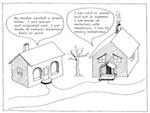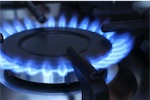To get the most heat and least amount of pollutants from firewood, it is best to use dry wood.
There are four simple steps to drying firewood: split, stack, cover, store. Firewood should be seasoned for at least six months before burning – hard wood for a year. It should be split, stored outdoors off the ground and at least 10 feet (if possible) away from the house. It should be stacked neatly in crisscross layers so that adequate air circulation hastens drying. Be sure to cover the firewood with tarp paper or similar materials.
Dry, seasoned wood burns cleaner and more efficiently, saves money and helps reduce harmful pollutants inside and outside the house. But most people don’t check their wood is dry enough to burn. It is easy to test the dryness of wood. Purchase a moisture meter from a hardware store at around $25. Push the prongs into the wood and read the result from the meter. If the moisture content is less than 20%, then the wood is ready to be burned.
If you order seasoned wood, you may want to bring your moisture meter to measure the moisture content before placing the order. If a moisture meter is not available, use this simple though less accurate test – seasoned wood is darker, has cracks in the end grain, and sounds hollow when smacked against another piece of wood and feels lighter than wet/damp wood.
If you prefer wood burning fireplace, be sure to purchase one from the EPA-approved list. Some of these EPA-approved units may even qualify for a $300 tax credit.
Finally, safety is most important. According to the U.S. Consumer Product Safety Commission, more than 150 people die on average per year from CO poisoning, related to the use of combustion appliances, including wood stoves and fireplaces, in the home. Use EPA’s guidance to help you choose the right fireplace, and safety tips to protect your health when using wood stoves and fireplaces.








